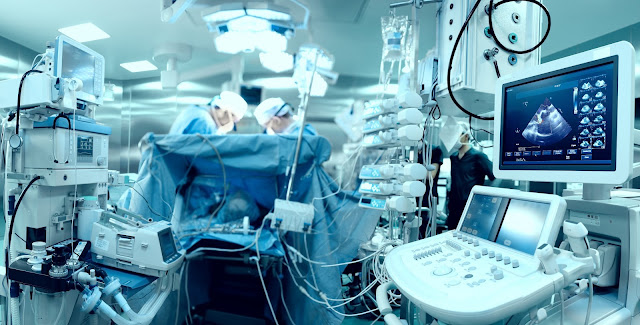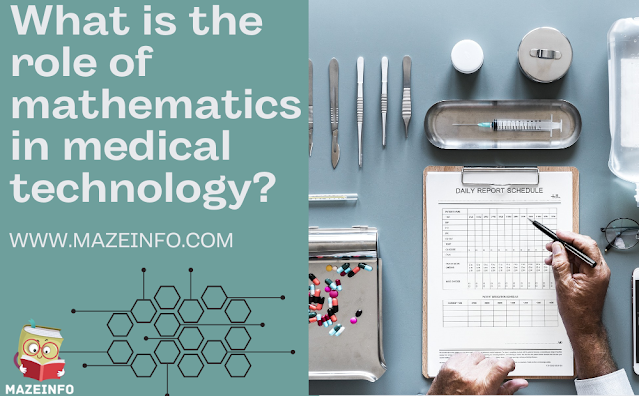In the dynamic realm of medical technology, the fusion of mathematics and healthcare has become indispensable, giving rise to innovative solutions that significantly impact patient care and diagnostic capabilities. The question that echoes through this intersection is, “What is the role of mathematics in medical technology?” This query opens the door to a profound exploration of how mathematical principles and techniques contribute to the advancement of medical devices, imaging technologies, and overall healthcare systems. From computational modeling to image processing, mathematics serves as the silent force driving progress in the development and refinement of cutting-edge medical technologies.
Medical Imaging Algorithms
In medical technology, mathematics is integral to the development of advanced algorithms for medical imaging.These algorithms, grounded in concepts like linear algebra and signal processing, enhance the quality of images from X-rays, CT scans, MRI, and ultrasound. mathematics in medical technology models play a crucial role in tasks such as image reconstruction in CT scans and segmentation for identifying structures within images. This synergy between mathematics and medical technology not only improves diagnostic accuracy but also drives innovation in imaging techniques, contributing to enhanced patient care and medical research.
Biostatistics and Epidemiology
Biostatistics and Epidemiology play crucial roles in the field of medical technology, providing the tools and methods necessary for collecting, analyzing, and interpreting data related to health and diseases. Let’s explore each of these disciplines in the context of medical technology:
Biostatistics in Medical Technology
Biostatistics plays a crucial role in the field of medical technology, providing a systematic approach to collecting, analyzing, and interpreting data related to health and disease. In medical research and clinical trials, biostatisticians utilize statistical methods to draw meaningful conclusions from complex datasets. Whether assessing the efficacy of a new medical device or analyzing patient outcomes, biostatistics ensures that findings are statistically sound and reliable. This discipline not only aids in decision-making but also contributes to the advancement of medical knowledge, enhancing the quality of health information technology.
Epidemiology’s Impact on Medical Technology
Epidemiology, as a cornerstone of public health, intersects with medical technology to understand the distribution and determinants of diseases in populations. By investigating patterns of health and illness, epidemiologists contribute valuable insights to the development and improvement of medical technologies. Through the analysis of disease trends and risk factors, epidemiology guides the implementation of preventive measures and informs the design of medical devices that address specific health challenges. Collaborations between epidemiologists and technologists lead to innovations that are not only effective but also tailored to the diverse needs of populations, promoting a more inclusive and impactful healthcare technology landscape.
Key Points of Intersection
- Both fields heavily rely on statistical methods to analyze data and draw valid conclusions.
- Biostatistics supports epidemiology by providing the tools for designing studies, analyzing data, and ensuring the validity of research findings.
- Epidemiology provides the context and real-world data for biostatistical analyses, helping to identify patterns, trends, and factors influencing health and disease.
Signal Processing for Diagnostic Tools

Mathematics plays a pivotal role in medical technology, particularly in signal processing for diagnostic tools. In applications like medical imaging and physiological signal analysis, advanced mathematical algorithms enhance signal quality, reduce noise, and extract vital information. This mathematical foundation is crucial for developing accurate diagnostic tools, enabling healthcare professionals to visualize internal structures, detect abnormalities, and monitor patient health effectively. The synergy of mathematics and signal processing is integral to the advancement of medical technology, improving diagnostic accuracy and ultimately benefiting patient care.
Drug Formulation and Pharmacokinetics
Mathematics plays a crucial role in the field of medical technology, particularly in drug formulation and pharmacokinetics. In drug formulation, mathematical models are employed to design and optimize the composition of pharmaceuticals, ensuring the delivery of the correct dosage with minimal side effects. Mathematical techniques such as differential equations and statistical analysis aid in understanding the kinetics of drug release, absorption, distribution, metabolism, and excretion within the human body.
Pharmacokinetics, a sub-discipline of pharmacology, relies heavily on mathematical modeling to quantify the movement of drugs in biological systems. These models help researchers and pharmaceutical scientists predict how drugs will behave in the body over time, allowing for the optimization of dosing regimens and the development of more effective and personalized treatments. Mathematical approaches, such as compartmental modeling and pharmacodynamic modeling, enable the simulation of drug behavior under various conditions, facilitating the identification of optimal drug concentrations and dosing intervals.
Health Informatics

Healthcare tech companies is the interdisciplinary field that involves the acquisition, storage, retrieval, and use of health information to support patient care, administration, research, education, and overall healthcare management. It encompasses the application of information technology and computational methods to healthcare-related data, fostering the efficient and effective use of information to improve health outcomes.
Key Components of Health Informatics
Data Management: healthcare technology involves the systematic organization, storage, and retrieval of health-related data. This includes patient records, medical images, laboratory results, and other pertinent information.
Health Information Systems: Implementation and maintenance of electronic health records (EHRs), health information exchange (HIE) systems, and other healthcare information systems to facilitate seamless data sharing among healthcare providers.
Health Information Standards: Development and adherence to standards that ensure consistency and interoperability in health data, allowing different systems to communicate and share information efficiently.
Clinical Decision Support Systems (CDSS): Integration of computerized tools and algorithms to assist healthcare professionals in making informed decisions about patient care, treatment plans, and diagnostics.
Telehealth and Telemedicine: Utilization of technology to provide healthcare services remotely, allowing for virtual consultations, remote monitoring, and improved accessibility to healthcare technology.
Health Analytics: The application of data analysis techniques to extract meaningful insights from new technology in healthcare data, aiding in decision-making, resource allocation, and identification of trends and patterns.
Also, Read More: What is High Functioning Anxiety, and Do I Have It?
Data Analytics
Data analytics involves the systematic analysis of raw data to derive meaningful insights, identify patterns, and make informed decisions. In the context of health informatics, data analytics plays a crucial role in leveraging vast amounts of healthcare data for improving patient outcomes, operational efficiency, and healthcare delivery.
Key Components of Data Analytics in Health
Descriptive Analytics: Examining historical data to understand what has happened, providing a baseline for further analysis. This involves summarizing and visualizing data to identify patterns and trends.
Predictive Analytics: Using statistical algorithms and math and medicine models to forecast future events or trends based on historical data. In healthcare, this can include predicting disease outbreaks, patient readmissions, or treatment responses.
Prescriptive Analytics: Recommending actions to optimize outcomes based on the insights derived from data. This involves providing actionable recommendations for healthcare providers to improve patient care and operational efficiency.
Big Data Analytics: Processing and analyzing large volumes of structured and unstructured data, often from diverse sources, to extract valuable information and insights.
Real-time Analytics: Analyzing data as it is generated in real-time, allowing for immediate decision-making and response, which is crucial in healthcare emergencies and critical situations.
Optimization in Healthcare Operations

In the rapidly evolving landscape of healthcare, the integration of mathematics and medical technology has proven to be a game-changer, particularly in the realm of optimizing healthcare operations. This synergy has facilitated enhanced efficiency, resource utilization, and overall improved patient care.
Precision Resource Allocation: Mathematics plays a pivotal role in optimizing resource allocation within healthcare facilities. Through advanced algorithms and data analytics, medical professionals can strategically allocate resources such as staff, equipment, and medications based on real-time demand, minimizing wastage and ensuring that resources are utilized where they are most needed.
Streamlining Patient Flow: The application of maths artificial intelligence in healthcare operations has significantly contributed to streamlining patient flow within hospitals and clinics. Optimization algorithms can analyze historical data to predict patient arrival patterns, enabling healthcare facilities to adjust staffing levels and bed capacities accordingly, reducing patient wait times and enhancing the overall patient experience.
Supply Chain Optimization: Efficient management of medical supplies and pharmaceuticals is critical in healthcare operations. Mathematics aids in optimizing supply chain logistics, ensuring that essential medical resources are stocked appropriately. By implementing mathematical models, healthcare tech providers can minimize stockouts, reduce excess inventory, and maintain a smooth and cost-effective supply chain.
Conclusion
In the realm of medical technology, mathematics serves as the backbone, enabling precision and efficiency in various applications. From enhancing the clarity of diagnostic imaging through algorithms to optimizing drug dosages, mathematical principles play a crucial role. Whether it’s simulating physiological processes or ensuring accurate medication administration, the integration of mathematics in mathematics in medical technology leads to advancements that significantly improve healthcare outcomes. In essence, the synergy between mathematics and medical technology is essential for driving innovation and precision in diagnosis, treatment, and patient care.
Frequently Asked Questions(FAQs)
Q: How does mathematics contribute to medical imaging?
Ans: Mathematics is essential in medical imaging for tasks such as image reconstruction, signal processing, and image analysis. Techniques like Fourier transforms and statistical methods are used to enhance and interpret medical images obtained through modalities like MRI, CT scans, and ultrasound.
Q: What role does mathematics play in medical modeling and simulation?
Ans: Mathematics is fundamental in creating models and simulations of biological systems, drug interactions, and disease progression. Computational models help researchers and clinicians understand complex physiological processes, design experiments, and simulate the effects of different treatments.
Q: How is mathematics applied in medical data analysis?
Ans: Mathematics is used in the analysis of large datasets in medical research, helping to identify patterns, trends, and correlations. Statistical methods, machine learning algorithms, and data mining techniques are applied to extract meaningful information from diverse medical data sources.
Q: In what ways does mathematics support medical research and drug development?
Ans: Mathematics is employed in the optimization of drug dosages, the analysis of pharmacokinetics and pharmacodynamics, and the modeling of drug interactions. Mathematical models aid in understanding drug efficacy and toxicity, facilitating the drug development process.
Q: Can mathematics help in personalized medicine?
Ans: Yes, mathematics contributes to the field of personalized medicine by analyzing genetic and clinical data to tailor treatment plans for individual patients. Predictive modeling and statistical methods assist in identifying patient-specific factors that influence treatment outcomes.
Q: How does mathematics enhance medical device design and optimization?
Ans: Mathematics is used in the design and optimization of medical devices, such as prosthetics, implants, and diagnostic tools. Finite element analysis, numerical simulations, and mathematical modeling contribute to the development of devices that are efficient, reliable, and safe for patient use.
Q: What role does mathematics play in understanding physiological processes?
Ans: Mathematics helps in formulating mathematical models to describe physiological processes within the human body. These models aid researchers in gaining insights into complex biological systems, understanding the dynamics of diseases, and predicting responses to interventions.
Q: How is mathematics used in medical statistics?
Ans: Medical statistics, a branch of applied statistics, employs mathematical techniques to analyze and interpret clinical trial data, epidemiological studies, and healthcare outcomes. Statistical methods help assess the effectiveness of treatments, evaluate risk factors, and make informed decisions in medical research.



